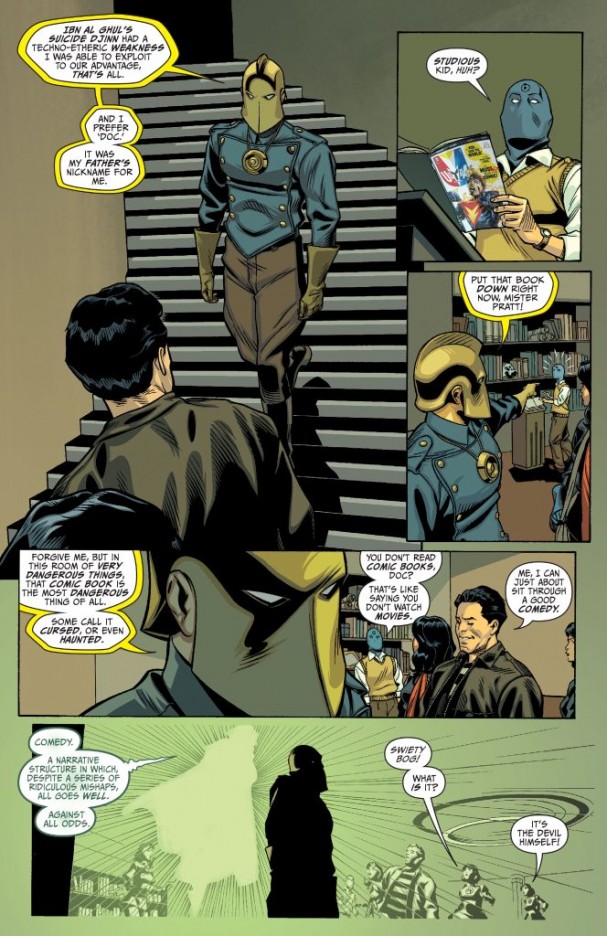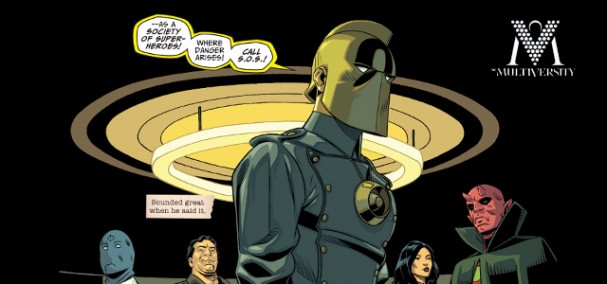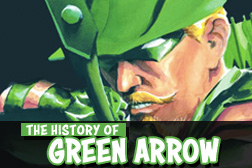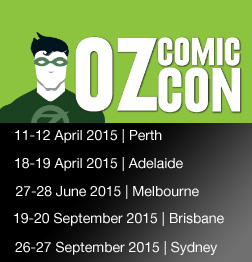The first of a series of standalone books set on alternate Earths gives us a flavour of what to expect over the course of Grant Morrison’s The Multiversity.
Writer: Grant Morrison
Artists: Chris Sprouse, Karl Story, Walden Wong, Dave McCraig
Letterer: Carlos M. Mangual
Publisher: DC Comics
Rating: 8.5/10
(Warning: review contains plot elements that may be considered spoilers)
With The Multiversity, writer Grant Morrison managed to introduce a fictional narrative around the notion that all stories are someone’s reality. More than that, both creators and audiences are active participants in the development of the story, and writers of our multiple destinies. To that end, the final page of the The Multiversity #1 left readers with the ultimate responsibility of how their comics unfold, which may just as easily be a piece of industry commentary as it is an expression of a deeply held philosophy.
Following on from this, The Multiversity: The Society of Super-Heroes: Conquerors of the Counter-World #1 is a standalone piece that also serves as part of Morrison’s interconnected multiverse. We’re introduced to the recently formed Society of Super-Heroes on Earth 20, an analogue for the Justice Society of America complete with a Golden Age glow about them. The S.O.S. is led by the ancient Immortal Man and encompasses familiar players like ‘Doc’ Fate, Mighty Atom and Lady Blackhawk. When worlds collide, they find themselves facing off against Vandal Savage and his parallel team-mates from Earth-40.
The trouble with reviewing anything in The Multiversity is that this is only one small part of something far more complex and holistic, although that same argument could be made for comics in general. While there is a complexity underlying the basic structure of the book, the main thrust of the piece is far more straightforward and familiar to the explosion of the beautiful weirdness that characterised the first chapter. It’s a scenario that harks back at least to the annual tradition of multi-Earth crossovers that began with the 1963 Gardner Fox scripted Justice League of America #21 (“Crisis on Earth One!”) and #22 (“Crisis on Earth-Two!”), or perhaps more aptly The Flash #137 (“Vengeance of the Immortal Villain!”, June 1963) given the presence of Vandal Savage. As such, the modern comics fan has seen these types of encounters for decades. Of course, it’s what Morrison knowingly relies on here, but not at the expense of a ripping good adventure.
As the title would imply, at the heart of The Multiversity: The Society of Super-Heroes: Conquerors of the Counter-World there’s the notion of duality. Each of the Earth-20 heroes has a counterpoint villain in Earth-40: Immortal Man and the more familiar Vandal Savage, Abin Sur/Sinestro, Doctor Fate/Doctor Faust and so on. The very deliberately chosen characters wage battle on and off panel, clashing ideologies and power-sets in equal measure. The Mighty Atom’s double Blockbuster appears to have his own narration. “WE WAITED UNTIL YOU WERE WEAK AND HURT BEFORE WE UNLEASHED OUR MEGATON MONSTER” comes, like Blockbuster, seemingly out of nowhere. “BEHOLD! THE BRUTE WITH THE BILLION-DOLLAR BRAIN!” screams an unseen spruiker. Is this directed at the Mighty Atom or the audience? As we were reminded in The Multiversity #1, the reading of comics imbues the audience with tremendous power.
 Tom Strong‘s Chris Sprouse is the ideal person to bring life to this retro-inspired yarn. His beautifully rendered character designs blend seamlessly with the neo Deco, Egyptian and ancient Latin American inspired architecture. Take Abin Sur, for example, who wears the long green cape with a distinctive high collar that shamelessly clashes with his red costume. It’s a visual nod to Alan Scott, the first Green Lantern, of course. Thanks to Dave McCraig’s inspired colours, the whole thing feels as though it is glimpsed through sepia sunglasses, the yellows, blues and browns of the S.O.S. outfits.
Tom Strong‘s Chris Sprouse is the ideal person to bring life to this retro-inspired yarn. His beautifully rendered character designs blend seamlessly with the neo Deco, Egyptian and ancient Latin American inspired architecture. Take Abin Sur, for example, who wears the long green cape with a distinctive high collar that shamelessly clashes with his red costume. It’s a visual nod to Alan Scott, the first Green Lantern, of course. Thanks to Dave McCraig’s inspired colours, the whole thing feels as though it is glimpsed through sepia sunglasses, the yellows, blues and browns of the S.O.S. outfits.
Narrated by Immortal Man, or more accurately diarised given the amount of text, there is a world weariness to some of the observations that comes with 40,000 years on the Earth. This makes the dawning realisation that the world is “much bigger, stranger, and more frightening” than he’d imagined all the more impactful. Like Morrison’s Seven Soldiers, this book can be treated single issue with one world’s heroes, and it serves a bible for future creators to take up these characters and run with it. Yet as the presence of the comic-within-a-comic “Ultra Comics” issue (by Grant Morrison and Doug Mahnke) makes its presence known in the chamber of Doc Fate, we get a link that will presumably run throughout all of the chapters. “That comic book,” warns Doc Fate, “is the most dangerous thing of all”. Forgive us for proceeding with reckless abandon.
Agree or disagree? Got a comment? Start a conversation below, or take it with you on Behind the Panel’s Facebook and Twitter!
If you are an iTunes user, subscribe to our weekly podcast free here and please leave us feedback. That’s how we get more attention on the Interwebs!











